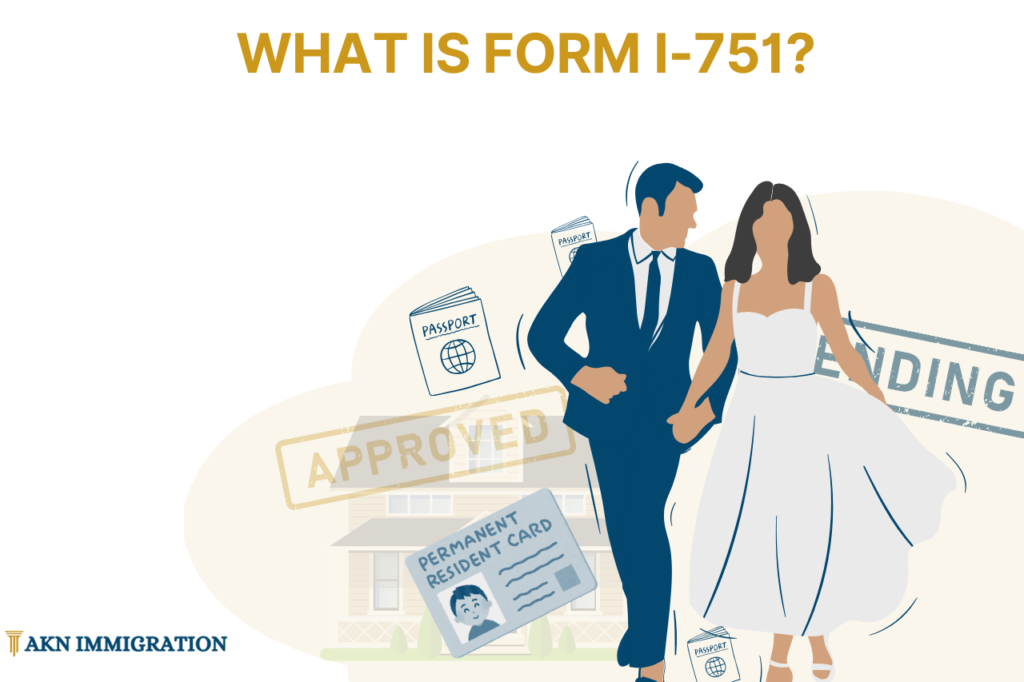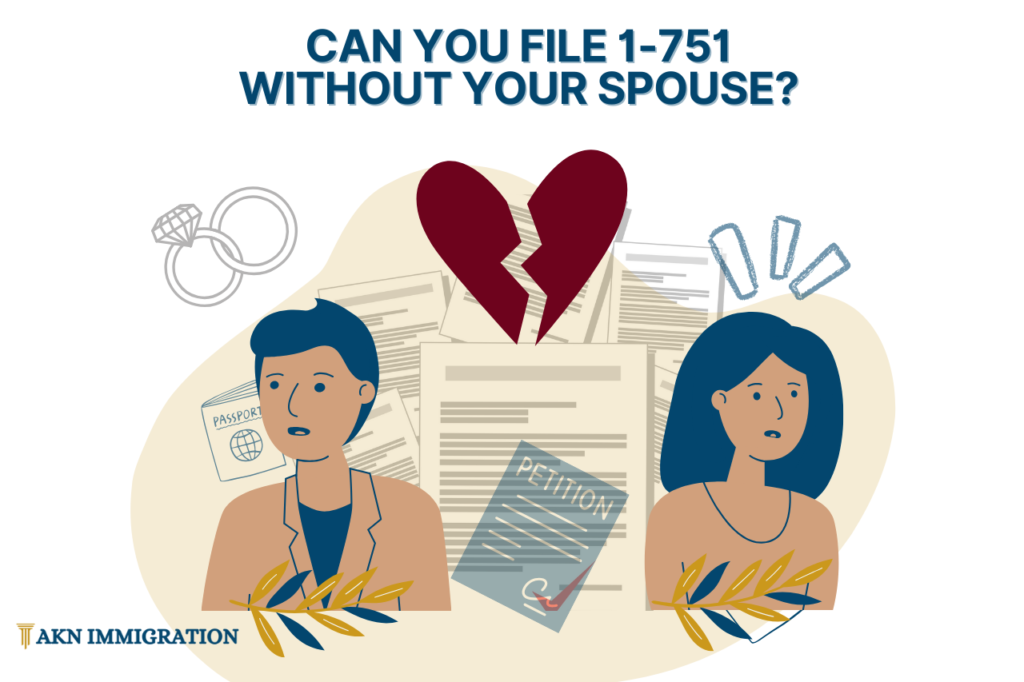Are you looking to understand the purpose of Form I-751? If you’ve recently tied the knot and acquired a conditional green card valid for just two years, Form I-751, or the “Petition to Remove Conditions on Residence,” is your pathway to securing a more enduring and renewable 10-year green card. Let’s break it down. You can also find information on Form I-1693, here.
⚠️ Entrepreneurs who obtained a conditional green card through investment would need to file a different form, called the I-829. For more information about this application please call us.

What is the purpose of Form I-751?
This essential document allows conditional residents who obtained their status through marriage to request the removal of conditions on their residence. By filing this petition with U.S. Citizenship and Immigration Services (USCIS), you’re taking steps toward becoming a permanent resident of the United States.USCIS imposes conditions on residence for individuals who obtain their green cards through marriage to ensure the legitimacy and bona fides of the marital relationship.
The two-year conditional period allows USCIS to evaluate whether the marriage was entered into in good faith and not to evade immigration laws. Form I-751 enables conditional residents to demonstrate the authenticity of their marriage and request the removal of these conditions, paving the way toward full permanent residency of 10 years in the United States.
Who May File the Form I-751?
Anybody who obtained conditional resident status through marriage to a U.S. citizen or lawful permanent resident may file Form I-751 to remove residency conditions. If you’re still married, it is recommended that you file Form I-751 jointly with your spouse through whom you obtained conditional status.
If you have dependent children who acquired conditional resident status on the same day as you or shortly after that, include their information in Part 5 of your Form I-751 to request the removal of conditions on their status. If your dependent children did not acquire conditional status at the same time or within 90 days after that, they’ll need to file separate Form I-751 petitions.
Can you file Form I-751 without your spouse?

Filing Form I-751 jointly with your spouse is typically preferred as it demonstrates your marriage’s authenticity and commitment to maintaining residency in the United States. This collaborative approach strengthens your case for removing conditions on your residency and can expedite the processing of your petition. It emphasizes your mutual intention to establish a lasting life together in the United States.
However, there are circumstances where you can file Form I-751 separately from your spouse. USCIS will consider your application under the following circumstances:
- Death of Spouse: If your spouse passed away after obtaining conditional resident status, you can file Form I-751 on your own to request the removal of conditions.
- Divorce or Annulment: If your marriage ended in divorce or annulment, you can file Form I-751 by yourself, demonstrating that the marriage was entered into in good faith.
- Abuse or Extreme Cruelty: If you experienced abuse or extreme cruelty from your spouse, you can file Form I-751 without your spouse’s participation.
- Abuse by Parent’s Spouse: If you are a dependent child of a conditional resident parent and have experienced abuse or extreme cruelty from your parent’s U.S. citizen or lawful permanent resident spouse, you can file Form I-751 on your own.
- Extreme Hardship: If your removal from the United States would result in extreme hardship, you may qualify to file Form I-751 without your spouse’s involvement.
These exceptions allow individuals in specific circumstances to seek the removal of conditions on their residency independently of their spouse’s participation. Each situation requires careful consideration and documentation to support the petition effectively.
When it comes to filing Form I-751, timing is crucial. If you’re filing jointly with your spouse, ensure you submit your petition during the 90 days immediately before your conditional residence expires. This timeframe is critical to avoid any lapses in your residency status.
If you find yourself in a situation where filing individually is necessary, you have more flexibility in timing. You can submit Form I-751 at any time after being granted conditional resident status and before facing removal from the United States. This means you don’t have to wait for the 90 days before your conditional residence expires.
You may file Form I-751 without your spouse if they are deceased, you are divorced, or you and your conditional resident child were battered or subjected to extreme cruelty. This flexibility allows you to address your residency status promptly and effectively based on your unique circumstances.
What if my Form I-751 application is denied?
If your Form I-751 application is denied, it can be due to several reasons:
- Fraudulent Marriage or Judicial Annulment: If USCIS discovers during the 2-year conditional period that the marriage was fraudulent or judicially annulled, or if the applicant paid a fee for filing another application for immigrant status, the application may be denied.
- Fraudulent Marriage or Judicial Annulment: If USCIS discovers during the 2-year conditional period that the marriage was fraudulent or judicially annulled, or if the applicant paid a fee for filing another application for immigrant status, the application may be denied.
- Failure to Attend Interview or File Joint Petition: The application can be denied if the applicant fails to attend the interview or file a joint petition within the appropriate timeframe.
- False Information: If the application contains false information, it can lead to denial.
If your application is denied for any of these reasons, USCIS will issue a Notice to Appear (NTA), and you will be required to attend removal proceedings at an immigration court. If you wish to argue your case, you can submit a new Form I-751 based on different grounds. While waiting for USCIS to consider your new application, you can file a motion to continue your removal proceedings. If the new Form I-751 is approved, you can then file another motion to terminate the removal proceedings.
During this process, your conditional residence will remain valid until the conclusion of the proceedings. It’s essential to promptly address the denial and seek legal guidance to navigate the proceedings effectively.
What is the Processing Time for Form I-751?
Processing times for Form I-751, may differ depending on the USCIS office overseeing the case. The current processing time can range from a few months to more than a year, even after capturing your biometrics. Regularly check the USCIS website for the most up-to-date processing times, as they can change due to various factors .
Form I-751 FAQs
What happens if you do not file form I-751 on time?
Failing to file Form I-751 can have serious consequences. It could result in losing your permanent resident status two years from the date you were granted conditional status, ultimately resulting in removal from the United States.
However, if circumstances beyond your control caused a delay in filing, you still have options. You can submit your petition late with a written explanation to USCIS, requesting them to excuse the late filing. USCIS may excuse the delay if you demonstrate that the failure to file on time was due to extraordinary circumstances beyond your control and that the length of the delay was reasonable. This flexibility allows you to address delays effectively and seek relief from potential repercussions.
How Should I Draft an I-751 Cover Letter?
While it’s not mandatory to include a cover letter with your Form I-751 application, drafting one can be advantageous, especially if your case has unique circumstances that may raise questions for the USCIS officer. A well-crafted cover letter can address potential concerns upfront, potentially reducing the need for additional evidence requests during the review process.
- Purpose of a Cover Letter:
- Address Concerns: Use the cover letter to explain any unusual aspects of your case, such as living separately from your spouse, to provide context and clarity.
- Summary of Application: Provide a concise overview of the contents of your petition package, listing the documents included and their significance.
- How to Draft an I-751 Cover Letter:
- Personal Details: Begin with your full name, address, and alien registration number.
- Date: Include the current date at the top of the page.
- Address: Direct the letter to the specific USCIS service center where you are submitting your petition.
- Subject Line: Clearly state the purpose of your letter, including your full name and alien registration number.
- Salutation: Greet the USCIS officer politely, such as “Dear USCIS Officer,”.
- Introduction: Briefly introduce yourself and state that you are filing Form I-751 to remove conditions on your residence.
- Body of the Letter: List and describe the documents included in your petition package, emphasizing evidence of your marital relationship and other supporting materials.
- Explain Unique Circumstances: If there are any special circumstances or changes that require attention, explain them clearly in this section.
- Conclusion: Restate the purpose of the letter, express gratitude for the officer’s consideration, and sign off with “Sincerely,” followed by your signature and printed name.
Navigating the cover letter drafting process can be daunting, but we’re here to help. Our team can assist you in crafting a professional and comprehensive cover letter tailored to your unique circumstances, ensuring a smoother application process. Book a call with us today to learn more about how we can support you throughout your Form I-751 petition.
Where Can I Find the I-751 PDF?
You need guidance on where to find the I-751 form and its instructions. You can easily access these documents as PDFs on the USCIS website. We will, however, compile all these documents so you can start your petition.
As you embark on your journey towards unconditional permanent residency, know that AKN Immigration is here to support you every step. Our team of dedicated immigration attorneys is well-versed in navigating the complexities of the immigration process and can provide you with expert legal guidance tailored to your unique situation.
Whether you have questions about filling out forms, understanding USCIS guidelines, or need assistance overcoming any obstacles that may arise, we are committed to ensuring your success. Contact us today to ensure your Form I-751 petition is handled with care and expertise, empowering you to achieve your immigration goals confidently. We’ll guide you through the process, from accessing the necessary forms to submitting your petition to the correct address.
What Are the Fees Associated with I-751?
When filing Form I-751, it’s important to be aware of the associated fees, which have been updated as of April 1, 2024. Here’s what you need to know:
- Fee Breakdown:
- Filing Fee for Form I-751: $750
- Biometric Fee: $85 per person, including yourself and each dependent included in your I-751 petition.
- Fee Waivers:
- You may be eligible for a fee waiver based on household income, receipt of means-tested benefits, or financial hardship.
- Payment Methods:
- Accepted payment methods include:
- Money orders
- Personal checks
- Cashier’s checks
- Credit card payments using Form G-1450 (when filing at a USCIS Lockbox facility)
What evidence and supporting documents are required for the I-751 petition?
When it comes to navigating the I-751 petition process, meticulous documentation is crucial to support your case effectively. Here’s a breakdown of the key pieces of evidence and requirements you’ll need to fulfill the following;
a. Submission Requirements:
i) Permanent Resident Card Submission:
- Include copies of your permanent resident card and those of any conditional resident children listed in your petition.
ii) Exception for Overseas Residents (Military or Government Orders):
- Provide two passport-style color photos for each petitioner and dependent.
- Submit two completed fingerprint cards (Form FD-258) for each petitioner and dependent aged 14 to 79.
- Indicate “ACTIVE MILITARY” or “GOVERNMENT ORDERS” at the top of Form I-751.
iii) Evidence of Relationship:
- Birth certificates of children born during the marriage.
- Lease or mortgage contracts showing joint occupancy or ownership of your shared residence.
- Financial records demonstrating joint ownership of assets and shared liabilities.
- Affidavits from at least two individuals who have known both spouses since the conditional residence was granted.
- Other relevant documents supporting the authenticity of the marriage.
b. Additional Documentation:
i) Death of Spouse:
- Include a copy of the death certificate with your petition, along with evidence of the qualifying relationship.
ii) Divorce or Annulment:
- Submit a copy of the final divorce decree or annulment document with your petition, along with evidence of the qualifying relationship.
iii) Abuse or Extreme Cruelty:
- Provide evidence of the abuse, such as reports from police, courts, medical personnel, or social workers.
- Include any legal documents related to orders of protection or legal actions taken against the abuser.
iv) Extreme Hardship:
- Submit evidence demonstrating that your removal from the United States would result in extreme hardship significantly greater than that encountered by other foreign nationals facing removal.
c. Criminal History:
- Include documentation related to any arrests, charges filed, convictions, or alternative sentencing programs.
d. Late Filing:
- If you are filing late due to circumstances beyond your control, submit a written explanation requesting USCIS to excuse the delay.
Filing Form I-751 correctly and comprehensively is essential to ensure the success of your petition and maintain your permanent resident status. Each requirement substantiates the authenticity of your marriage and ongoing relationship, demonstrating your eligibility for removing conditions on your residency.
TLDR ( Too Long Didnt Read):
Form I-751, the Petition to Remove Conditions on Residence, is crucial for conditional permanent residents who obtained their status through marriage to a U.S. citizen or lawful permanent resident. This form allows individuals to request the removal of the two-year conditions on their residency, transitioning to a full 10-year green card for permanent residency in the United States.
The process involves submitting evidence of a genuine marital relationship, including documentation like joint leases, financial records, and affidavits from acquaintances. Filing correctly and on time is vital to maintain legal status. If you need assistance navigating the complexities of Form I-751, our dedicated team at AKN Immigration is here to provide expert guidance tailored to your unique situation. Don’t hesitate to reach out for support and ensure a smooth path to unconditional permanent residency.






